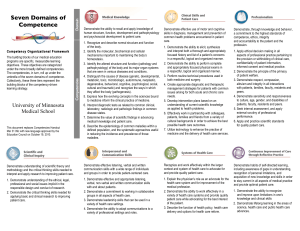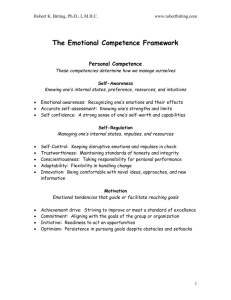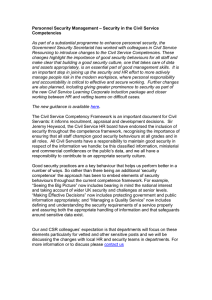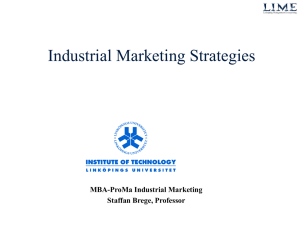Approaches to Educational Programs Modeling, Design and Implementation for
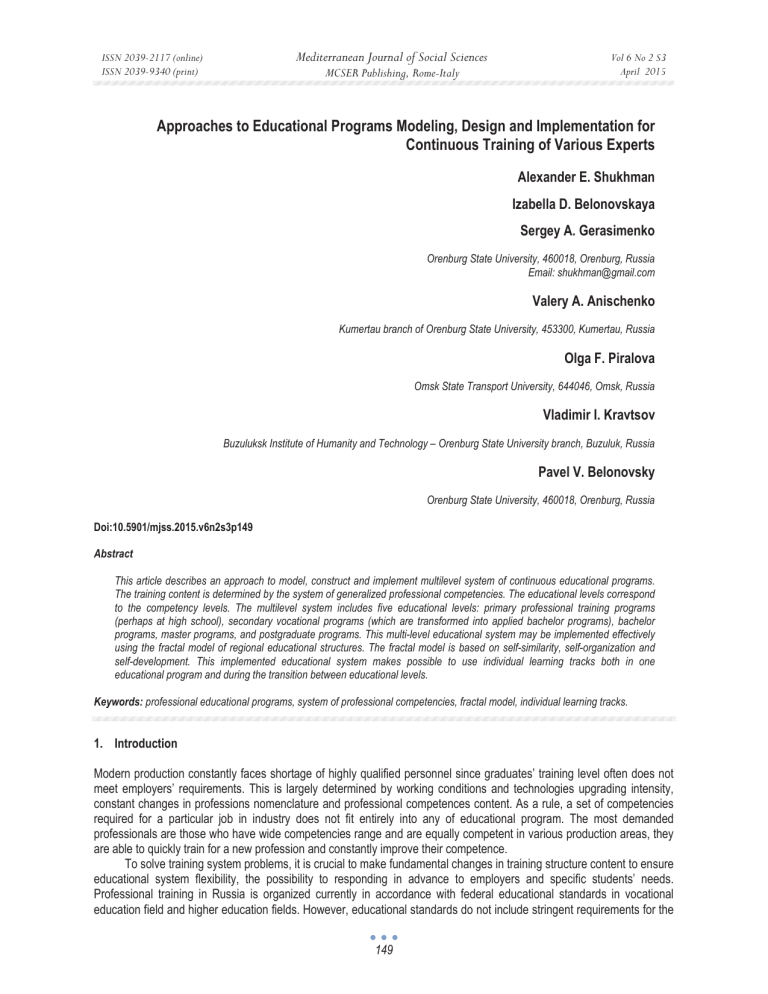
ISSN 2039-2117 (online)
ISSN 2039-9340 (print)
Mediterranean Journal of Social Sciences
MCSER Publishing, Rome-Italy
Vol 6 No 2 S3
April 2015
Approaches to Educational Programs Modeling, Design and Implementation for
Continuous Training of Various Experts
Alexander E. Shukhman
Izabella D. Belonovskaya
Sergey A. Gerasimenko
Orenburg State University, 460018, Orenburg, Russia
Email: shukhman@gmail.com
Valery A. Anischenko
Kumertau branch of Orenburg State University, 453300, Kumertau, Russia
Olga F. Piralova
Omsk State Transport University, 644046, Omsk, Russia
Vladimir I. Kravtsov
Buzuluksk Institute of Humanity and Technology – Orenburg State University branch, Buzuluk, Russia
Pavel V. Belonovsky
Orenburg State University, 460018, Orenburg, Russia
Doi:10.5901/mjss.2015.v6n2s3p149
Abstract
This article describes an approach to model, construct and implement multilevel system of continuous educational programs.
The training content is determined by the system of generalized professional competencies. The educational levels correspond to the competency levels. The multilevel system includes five educational levels: primary professional training programs
(perhaps at high school), secondary vocational programs (which are transformed into applied bachelor programs), bachelor programs, master programs, and postgraduate programs. This multi-level educational system may be implemented effectively using the fractal model of regional educational structures. The fractal model is based on self-similarity, self-organization and self-development. This implemented educational system makes possible to use individual learning tracks both in one educational program and during the transition between educational levels.
Keywords: professional educational programs, system of professional competencies, fractal model, individual learning tracks.
1.
Introduction
Modern production constantly faces shortage of highly qualified personnel since graduates’ training level often does not meet employers’ requirements. This is largely determined by working conditions and technologies upgrading intensity, constant changes in professions nomenclature and professional competences content. As a rule, a set of competencies required for a particular job in industry does not fit entirely into any of educational program. The most demanded professionals are those who have wide competencies range and are equally competent in various production areas, they are able to quickly train for a new profession and constantly improve their competence.
To solve training system problems, it is crucial to make fundamental changes in training structure content to ensure educational system flexibility, the possibility to responding in advance to employers and specific students’ needs.
Professional training in Russia is organized currently in accordance with federal educational standards in vocational education field and higher education fields. However, educational standards do not include stringent requirements for the
149
ISSN 2039-2117 (online)
ISSN 2039-9340 (print)
Mediterranean Journal of Social Sciences
MCSER Publishing, Rome-Italy
Vol 6 No 2 S3
April 2015 teaching content in educational programs providing a significant variable part that gives the flexibility to change training content. However, educational standards and training programs at various levels are often poorly coordinated; they are based on incompatible competence systems that lead to problems with ensuring the continuity of educational programs at different levels, the implementation of training opportunities in a shorter time and support to individual students’ educational tracks.
An approach to modeling and design proposed in this paper in order to form educational programs of vocational education is based on the development of a unified system of professional competencies.
The scientific problem, which has determined the research direction, consists of the need to systematize professional competencies and their integration into the generics that will establish approaches to modeling and design of educational programs at different vocational education levels, having continuity, variability, as well as consistency with professional standards at relevant economy industries characteristics. Domestic and foreign professional standards and qualification systems analysis showed that they could not be used directly for the educational content development, because, skills and competence are not integrated as qualifying knowledge characteristics. There is a need to model professional competences structure, the allocation of levels of competence, developing each profession’s qualifications based on an adequate level of competence definition.
2.
Methodological Framework
2.1
Competence-based approach
Competence approach is fundamental to our study since it is based on competence and expert knowledge concepts
(Hall, 1976). Competence approach defines learning outcomes in terms of professional competencies. Competence as a complex notion consists of various meaningful components: knowledge, skills, values, experience (Hobart, 1995).
Substantial competence components are usually grouped into several hierarchical levels, determining relevant activities independence degree and responsibility.
There are different approaches to define competence level. These levels often correspond to the learning levels outcomes within Bloom's taxonomy framework (Bloom, 1956). In previous publications we proposed the competences structure for innovative industries, based on staff’ professional activities results (Belonovskaya, 2012).
Comparing activities outcomes and education levels it’s possible to distinguish five competency levels integrated into each other as the complexity increases, it grows by functionality, complexity and independence of result achievement.
The first level - preparedness to practical action based on a typical algorithm. This is considered to be professional
- personal quality is ensured in the short initial training and involves a detailed description of the employee’s simple labor actions.
The second level - preparedness for self-regulated responsible actions involves extensive use of skills in this competency in practice, basically at standard situations, in accordance with existing regulations, providing liability for executive actions and limited autonomy in decision-making.
The third level - preparedness to self-applied practice in terms of innovation, involves activities related to the solution of problems in unusual situations, control and subordinates actions correction, provides liability for performers group actions, sufficient autonomy in decision-making. Innovative activities can be assumed at this due to the need to introduce new technologies and processes.
The fourth level - preparedness to design and construct, develop and implement innovative products, technologies and services, involves solving problems and applications, methodology knowledge and general principles of decisionmaking in the innovation sector, provides responsibility for the actions on collective level, independence in decisionmaking, initiative, innovation and efficiency drive.
The fifth level - preparedness to research and forecast in the field of innovation, involves activities in methodology field and the development of general principles of this competence, fundamental decisions affecting organization’s overall activities, expertise activities and products, managing a group of workers, provides responsibility for collective’ actions and high autonomy in decision-making.
2.2
Methods of competences formation
We have developed a method of generalized competence system which includes preliminary list of competencies and their content based on professional and educational standards, defines subjects who update generic competences
150
ISSN 2039-2117 (online)
ISSN 2039-9340 (print)
Mediterranean Journal of Social Sciences
MCSER Publishing, Rome-Italy
Vol 6 No 2 S3
April 2015 description versions, and interact with subjects to clarify the role and resources of each to form generalized competencies system survey, to clarify the structure and substantive content of generalized competences, subjects representations correlation analysis and generalized competencies content correction.
The aim to attribute professional standard units (knowledge and skills), the results of which serve to educational programs, to specific professional competencies, as well as to their specific levels, causes considerable difficulties. At the initial stage of competences structure formation we propose to use statistical methods related to cluster analysis. The initial clusters allocation, which are future competencies basis, can be made based on expert contents estimations within professional standards. For clusterization k-average method can be used. Elements having only one nonzero component by all experts’ opinion are selected as cluster centers (obviously specified within a certain competence in advance).
2.3
Technique to educational content design
Educational programs content is based on a given level of specialist professional competence. Each level corresponds to a certain professional education competence level: initial vocational training, vocational education, undergraduate, graduate, post-graduate courses. Training profiles at every level of professional education correspond to the main occupations at innovative industries.
It is necessary for each economic sector to develop competences content and define a relevant professions matrix and certain levels of professional technological competencies. The matrix identifies a set of competencies that should be formed for a particular profile by educational program. Based on this set of competencies, it is possible to determine the variable part of professional discipline cycle of basic educational program.
2.4
Fractal model of educational programs
Continuous multi-leveled effective implementation training is possible when coordinating educational programs at various levels; it is possible when using a fractal model of the university complex. The term "fractal" was introduced in the mid 70ies of XX century by Benoit Mandelbrot to describe self-similar geometric shapes (Mandelbrot, 1983). Self-similarity means that any subsystem of fractal system follow the configuration of the whole system. Fragment of a fractal-like holistic form is reproduced at each successive level on a smaller scale, forming a kind of "nested" structure. Fractal models are used in teaching because they allow describing a complex of educational systems development.
Under the university campus structure, we mean a set of relations and educational institutions and structures to implement continuing professional education programs. The main components that characterize the university as educational system, are university’, branch’, college’ educational environment necessary for their educational, scientific and industrial base, information technology facilities, social and cultural destinations near schools or educational units
(conventionally called as campuses).
The basic model’s element or generator, if we use the terminology of fractals theory, we will consider interaction of the university and its divisions. Each educational unit, in turn, has self-similarity characteristics, and therefore, can be considered as fractals.
The University campus provides various opportunities: it gives students multileveled education (secondary, higher and postgraduate); provides favorable conditions for commercialization of science-technological development (knowledge transfer); forms a unified methodology for vocational education; reveals students’ individual creativity abilities. In this respect, University campus should include a variety of educational institutions with different location and profile. The distributed structure arising from these regulations forms a branch network.
Fractal structure advantages are stipulated by various education levels in linear fractals "college - university" and
"college - branch"; by variability and adaptability of branched fractal "leading university - branches"; by focus on subordinate fractals self-development (i.e. branches).
The most complete consistency among various educational programs is provided by fractal model, which allows support of individual educational students’ tracks.
2.5
Students’ individual educational tracks modeling
Each professional education program includes both compulsory courses, modules, and elective courses. Each student creates his own educational track, choosing courses at the beginning of school year or semester. Often courses are chosen unconsciously, without taking into account future graduate qualification requirements.
We have developed effective methods for students’ individual educational tracks design and maintenance at
151
ISSN 2039-2117 (online)
ISSN 2039-9340 (print)
Mediterranean Journal of Social Sciences
MCSER Publishing, Rome-Italy
Vol 6 No 2 S3
April 2015 regional multi-level vocational education system, providing a conscious achievement of learning outcomes in the form of competencies demand on the labor market (Shukhman, 2013). In this approach, a two level when selecting path. The first one involves selection of training areas and educational program profile at a certain level of professional education, and the second determines subjects’ choice in variable educational program part.
As a basis for educational tracks design, we used education content model based on the above-described system of generalized professional competencies that define the learning outcomes at all training levels.
Education content model includes standards, generalized professional competencies at various levels, disciplines content in the form of didactic units, as well as the interrelation of disciplines and competencies.
3.
Results
3.1
Development of professional competencies content in IT industry.
The elaborated method was used developing competences’ structure and content for IT industry. Preliminary generalized professional competencies list and content are based on IT industry professional standards. Professional standards in
Russia include job descriptions and their respective qualification levels, types of employment and job functions that require specific knowledge and skills. After core competencies, separation it was noted that learning outcomes were unevenly distributed across clusters. Thus, the most overloaded clusters proved to be "software development" and "IT
Management". As a result, each of these clusters has been divided into several competencies: in the first case, the object of dividing became the element relevance to one of the software development stages, the second – management object.
Thus, competences are defined as: "Project Management", "Human Resources", "Interaction with users and customers", "Business processes analysis and modeling", "Resource Management" at the aggregated group competencies "IT management" and "”Software requirements collection and analysis", "Software design ", "Development code", "Testing and debugging software", "Software maintenance" competences at the aggregated group competencies
"Software development ".
At further steps, content competencies were clarified and corrected based on educational process opinion analysis: students, teachers and employers. Developed generalized competences system for IT industry allows creating educational programs continuity for different levels of professional education.
3.2
Educational training programs design in using fractal model within continuing education system
Based on standards analysis of general education and basic vocational education specialized educational programs with information-technological profile have been developed for high school training in IT sphere (Shukhman, 2012).
Theoretical part of training is realized using core disciplines (mathematics, computer science and physics) and elective in curriculum. Practical part of training (educational and industrial practice) is carried out in the framework of extra-curricular project, scientific, educational and public benefit seniors. Training results are defined in the form of common cultural and professional competences. Only first two initial levels of each competency at high school are possible to be formed.
Training programs for such professions as "Digital resources processing master" and "Computer networks adjuster” are developed. The elaborated programs correspond to the first qualification level on the relevant professions in
IT industry: "Information resources specialist" and "System Administrator". These programs have been tested at schools and institutions of further education of Orenburg region in cooperation with Orenburg State University.
The developed method has been applied at the Orenburg State University to construct a multi-level training system in IT sphere. The developed model for Bachelor degree education allows train specialists within the six most popular professions in IT: "Information resources specialist," "System administrator", "Programmer", "Database Administrator",
"Information resources specialist", "Systems Analyst". Correspondence between professional competence and qualification levels in each profession to structure training disciplines are encouraged to use the block-modular approach.
To develop a modular training structure the blocks correspond to the basic professional competences (or aggregated groups of competences). Each unit contains separate training modules corresponding to specific topics selected for some competence on the basis of their complex internal structure.
Each module contains theoretical and practical part, which correspond to specific tasks within educational and practice internship. To develop training modules content we have proposed an algorithm based on the professional competencies content, the development technique of basic educational program is also justified.
An integrated competence system for educational programs at all training levels leads to the fact that programs
152
ISSN 2039-2117 (online)
ISSN 2039-9340 (print)
Mediterranean Journal of Social Sciences
MCSER Publishing, Rome-Italy
Vol 6 No 2 S3
April 2015 structure at each level become similar. This training system can be implemented efficiently using a fractal education model. Orenburg State University structure can be described as a fractal model since its units (branches, departments, and colleges) have a structure similar to the whole University.
The University (OSU) has five branches in Orenburg region and the Republic of Bashkortostan and consists of five colleges. Contingent of students at OSU with branches and colleges is more than 30 thousand people (including 18 000 people - in the main high school). The structure of main campus includes three colleges operating in the city of Orenburg:
Electronics and Business College, Industrial and Teaching College, Humanities College of Law. Each has a welldeveloped material and technical base which belongs to operational management of OSU.
OSU branches structure have fractal characteristics: Buzuluk Humanities and Technology Institute has Buzuluksk
Industry and Transport College in its structure. Orsk Humanitarian-Technical Institute, the largest branch school in
Orenburg region, collaborates with Orsk Polytechnic College that is a branch of OSU as well. These schools implement secondary and higher vocational education continuity using material and technical base under the OSU operational management. Kumertau OSU branch, located in the Republic of Bashkortostan, originally has been developed on the basis of Kumertau mountain college, but recently has created a developed material and technical base, located in the operational management of OSU.
3.3
Effective modeling of students individual educational tracks
Petri nets (Petri nets) model has been used as a basis for individual educational track modeling (Shukhman, 2013).
Positions (places) in Petri nets are learning outcomes (units of competency), transitions in this network are separate disciplines, modules, courses of educational programs in the regional education system.
Arcs in Petri nets are defined based on relationships between learning outcomes and courses: To complete the course requires initial knowledge level, skills, after completing the course one will reach a certain level of knowledge and skills. The level of students’ competence is given in the form of marking Petri net, the learning process is aimed to change labeling through a sequence of transitions in the network. Additional top points are added aggregating disciplines, as well as in situations where competence is formed by a set of disciplines.
The search for the best educational tracks is to find the optimal path in the accessibility system within Petri nets.
We propose a heuristic algorithm to design a track as a path in the status graph at Petri nets. The algorithm had been optimized in comparison with the full accessibility tree. The analysis of the algorithm correctness performance had been conducted; we obtained all necessary and sufficient conditions for the existence of individual educational tracks, and proposed methods for its verification.
We have revised two different optimization criterion of individual educational tracks: the first - to achieve the highest competence level, expressed in the generated knowledge and skills volume, including compulsory learning outcome under given constraints; the second - to minimize total complexity of disciplines necessary for the formation of mandatory learning outcomes. In the first case, the optimization problem is to modify the rucksack problem - NP-complete problem on rucksack with the union of sets. The approximate algorithm has quadratic complexity, taking into account disciplines relationship of educational program based on an algorithm (Arulsevan, 2014). In the second case, the optimization problem is reduced to an NP-complete problem of minimal covering.
Based on the proposed methodology a distributed information system has been designed in the form of internet resource available for students and employers.
4.
Discussions
Using the fractal model contributes to:
• economic efficiency due to territorial concentration of various educational resources, applying after testing in other fractals schemes, identity management processes fractals, the ability to automate the universal management procedures and document flow;
• self-organization: in branches that are organized as a head university, as they are developing, faculties, departments, remote information technology centers, additional education systems will arise, forming their own material and technical base and research perspective;
• self-recovery: in problem situations educational activities at one of the institutions can provide resource support or can temporary accept students for education;
• self-development: the interaction of colleges and universities within each fractal allows to raise the education
153
ISSN 2039-2117 (online)
ISSN 2039-9340 (print)
Mediterranean Journal of Social Sciences
MCSER Publishing, Rome-Italy
Vol 6 No 2 S3
April 2015 level of graduates, educational and scientific qualifications of teachers, to develop scientific and educational and informational environment;
• accessibility and openness of continuing education within the region.
Flexibility and customization of program content is achieved by introducing students’ individual educational tracks as in one of the educational programs and the educational system as a whole. For optimal design and maintenance of students’ individual educational tracks can effectively use the information system based on the model of educational content and the learning process in the form of Petri nets.
The developed system will enable student to make mindful choices within study areas, disciplines profiles within the educational profile, additional educational programs, taking into account existing set of competencies and the specified learning outcomes.
The developed system allows the employer select graduates with necessary competences based on educational programs analysis, defining optimal ways to retrain personnel.
5.
Conclusion
Proposed approaches to multi-level continuous training design and modeling based on a unified system of professional competencies can design continuity of educational programs for professional education’ different level. This ensures consistency of programs at various levels, maximum skill requirements matching for employers and graduates.
Proposed models and techniques can be used when developing continuous education programs in organizations that train IT professionals, which will improve the quality of training, demand for graduates in labor market.
References
Arulselvan, A. (2014) A note on the set union rucksack problem. Discrete Applied Mathematics (No. 169, pp. 214–218).
Belonovskaya, I., Shukhman, A., (2012) Continuous educational programs constructing for training specialists in innovative branches of economy on the basis of generalized competences system. Proceedings of the International Conference on Interactive
Collaborative Learning (ICL 2012), DOI: 10.1109 / ICL.2012.6402100
Bloom, B.S.; Engelhart, M.D.; Furst, E.J.; Hill, W.H.; Krathwohl, D. R. (1956). Taxonomy of educational objectives: The classification of educational goals. Handbook I: Cognitive domain. New York: David McKay Company.
Hall, G.E. (1976) Competency-based Education: A Process for the Improvement of Education: Prentice-Hall (376 p.)
Hobart, B., Lundberg, D. (1995) Competency-based Education and Training: Between a Rock and a Whirlpool. Macmillan Education AU
(337 p.)
Mandelbrot, B. (1983). The Fractal Geometry of Nature. San Francisco: W.H. Freeman.
Shukhman, A., Belonovskaya, I. ; Belonovsky, P. (2012) Professional training in the field of information technology at secondary schools
Proceedings of the International Conference on Interactive Collaborative Learning (ICL 2012), DOI: 10.1109/ICL.2012.6402176
Shukhman, A., Belonovskaya, I., Motyleva M. (2013) Individual learning path modeling based on generalized competencies system
Proceedings of the 2013 IEEE Global Engineering Education Conference (EDUCON) (pp. 1023-1026) DOI: 10.1109 /
EduCon.2013.6530233
154


